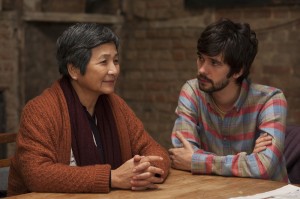
We were kind of destined to write about this one.
Daniel Warth’s Dim the Fluorescents exists as Dim the House Lights’ cosmic twin, a story of two creative types pouring heart and soul into the few projects they have audience for, however tiny, disinterested or bewildered it may be. They believe in what they do. They prop each other up as models of greatness among the phonies and sellouts. It’s weird that their thing is even a thing at all, but god dammit, it’s theirs, and it’s earnest. Dim the Fluroescents is also a a great joke played straight: what if the people responsible for putting together those HR-mandated demonstrations about workplace safety and sexual harassment in the office were really, really into it? But what could have been two hours of facile potshots at self-important writers and performers proves to be much more: a sharply-directed unpacking of a friendship tied up in creative ambition.
Audrey and Lillian (Claire Armstrong and Naomi Skwarma, both great) are roommates and creative partners. The former is a struggling actress who tears into her tiny seminar playlet roles with great zeal; the latter treats every reenactment like a pocket-sized emotional epic. They take their work very, very seriously. They’re professionals, you see. When they land a gig at a conference on leadership, they see it as their one big shot. There are hiccups: for example, they are told they can’t shatter real glass on stage. To them, this is an act of censorship, a shackling of their artistry; for the organizing manager, well, it’s an insurance thing. And he can maybe try to get Audrey and Lillian extra badges (or “tickets,” as they insist on calling them) on the condition that they include his niece in the proceedings. They do. They give her one line. Anything to stage their magnum opus, even including an outsider. But as the day of the performance approaches, their own hype starts to get to them, and both the partnership and the friendship starts to splinter.
If the script walks the razor’s edge between empathy and gentle ribbing towards Audrey and Lillian, Warth shoots their performances with theatrical flair. Cutting lighting, melodramatic blocking, intense close-ups, long Steadicam oners: nothing is off the table. There’s a refreshing excess to Dim the Fluorescents beyond its visual flourishes. There’s a gratuitous out-of-character Kevin-Bacon-in-Footloose dance sequence. There’s an excessively-detailed writing exercise that becomes its own short film for a couple of minutes. There’s a whole lost weekend segment where Audrey plays house with a pencil-pusher named Bradley (Brendan Hobin) that feels like it could have been written by Lillian herself, in her impeccably-designed room filled with the signifiers of a writer (colour-coordinated books, framed jazz albums, smokes). It’s the Tenacious D method taken to its logical endpoint: not only is the art itself shown filtered through the eyes of the creators, but that same viewpoint has crept into reality, fusing work and life, throwing off the balance.
Not everything gels: 128 minutes is a long time to sit with this premise. The pivot from comic to dramatic isn’t the most graceful, nor are its circumstances as laid out as the script needs them to be. But to its credit, there are grace notes upon grace notes to smooth over the rougher patches. The wardrobe department in particular deserves praise: everyone from the denizens of the cubicle farm to the Toronto theatre hipsters to the extras at a cafe are perfectly attired. The score (courtesy of co-writer Miles Barstead) is breezy and jazzy, and Toronto itself, from the shimmering spires of office buildings to the open-plan chic of the performance spaces, looks like a million bucks. Like the jacked-up safety skits contained therein, Dim the Fluorescents is ambitious and charming in equal amounts, wearing its archness like a badge of honour.



 Derek
Derek
 Isabelle
Isabelle